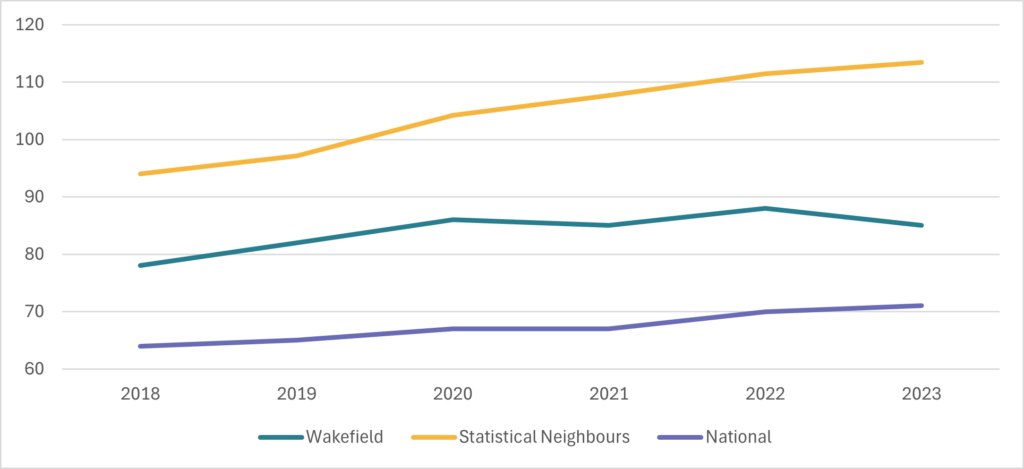Headlines
- As at 31st of March 2023 there were 636 children in care (CiC) in Wakefield was a decrease from the total of 650 in March 2022.
- The rate of children in care in Wakefield (per 10,000 population) was 85 in 2023 which was higher than the national rate of 71 but much lower than the statistical neighbour rate of 113.40.
- During 2023, there were more boys in care than girls with 56% of CIC being male and 44% female and by far the most common ethnicity for all CiC was white British (which has remained constant.
- The main reason for children coming into care is due to abuse and neglect which has been the case for a number of years.
- Following a decrease in 2022, the number of CIC who have had 3 or more placement moves remained lower than the national and statistical neighbour rates in 2023, however the percentage of CiC who had been in the same placement for over 2 years decreased and was lower than the national and statistical neighbour rates.
- There has been a significant improvement in the completion of annual health checks for CiC within specified timescales, increasing to 98% in 2023 which was higher than the national rate and statistical neighbour rate.
- Attainment for CiC in Wakefield was better than the national and statistical neighbour rate at key stages 2 in writing and maths and the overall progress score at key stage 4 was also better than the national and statistical neighbour rate.
- The average strengths & difficulties questionnaire (SDQ) rose in 2023 indicating that more CIC may have emotional support needs than in the previous year.
- In 2023 there was a small decrease in Care Leavers to 181 from 188 in the previous year.
- The percentage of Care Leavers who were not in education, employment or training was 44% in 2023 which was higher than the national and statistical neighbour rates.
The term Children in Care applies to children and young people up to the age of 18 for whom the Local Authority has either sole or shared parental responsibility. Children can be in care by agreement with parents or by order of a court. The aim in Wakefield is that the majority of CIC children who are in care will be living in a stable home environment with foster parents, whilst some will have their needs met living in a residential children’s home or within another residential setting with a small number living at home with parents whilst subject to a care order. Children and young people enter care due to range of circumstances and many have suffered abuse or neglect. Research has shown that experiencing abuse and neglect and other adverse childhood experiences along as well as other factors such as living in areas of deprivation impact disproportionately on CiC when compared with those who do not experience care. It is known that this can lead to poorer outcomes for young people leaving care such as:
- Lower attainment levels
- Increased likelihood of emotional and mental health issues
- Greater likelihood of experiencing poor physical health
- Economic and social disadvantage.
Research shows that many of these risks can be reduced when children in care have an effective care plan that meets their needs and a placement which is stable with good support from a range of agencies. The following summary of data provides information about children in care in Wakefield showing the trend over a period of time and how this compares to the rate for England along with the statistical neighbours for Wakefield. This includes information about the cohort along with outcomes including attainment and health and there is also data on Care Leavers. Commentary is included to indicate whether Wakefield levels differ greatly from the national and statistical neighbour rates and if this is an area for further analysis. Data included in this overview is published annually by the Department of Education (DfE) based on the financial year to 31st March which is collected through the SSDA 903 Census which is submitted by all Local Authorities. In reviewing this data some recommendations have been identified and details are provided on whether and how these are being addressed.
1. The Population
Table 1 – Rate of Children in Care (per 10,000 population)
| 2019 | 2020 | 2021 | 2022 | 2023 | |
| Wakefield | 82.00 | 86.00 | 85.00 | 99.00 | 85.00 |
| Statistical Neighbours | 97.10 | 104.20 | 107.70 | 111.50 | 113.50 |
| National | 65.00 | 67.00 | 67.00 | 70.00 | 70.00 |
Figure 1 – Rate of Children in Care (Per 10,000 population)
The rate of CiC (per 10,000 population) in Wakefield has increased over the last 5 years, from 78 in 2018 to 85 in 2023, with a small decrease between 2022 and 2023. This is higher than the National rate of 70 in 2023. The rate since 2018 has increased more sharply for our Statistical neighbours too with much higher rate of 113.5 as of 2023 (per 10,000 population). Since 2018, the Wakefield rate has remained below the Statistical neighbour rate but above the National rate, despite the same increasing trends displayed in the National rate seen in the Wakefield rate. The line graph visualise that all 3 rates discussed have slowly increased over the last 5 years.
There are 4 figures below on the interactive charts. These figures provide information about Wakefield Children in Care such as their Gender, Ethnicity, Area, Category of Need and SEN levels:
Notes below refer to the figures in the interactive charts above:
Figure 4: Children in Care- Category of need:
The most common reason why children come into care in Wakefield by far is ‘Abuse or neglect’ which has been consistent over a number of years. With the aim of ensuring that neglect is identified at an early stage the Neglect Toolkit has been developed through the Wakefield Children’s Safeguarding Partnership and training has been rolled out on a multi agency basis. The toolkit supports practitioners to identify neglect within the family setting addressing this through appropriate interventions in the care plan. Generally children and young people in care tend to have poorer outcomes in terms of health, education and overall wellbeing than children who have not experienced care. Closing the gap between the educational attainment of CiC and all children and young people is a key priority in Wakefield. A higher percentage of CiC require additional support at school compared with children who are not in care. The figure below shows the percentage of CiC identified with special educational needs (SEN) Statement or with an Education, Health & Care plan (EHCP).
Figure 5: % of CiC with EHCP or SEN Support:
In Wakefield, 27.8% of CiC had an EHCP in 20223 which was lower with the National and Statistical Neighbour rate, but higher than the Statistical neighbour rate of 27.87%. Combining the2 percentages of those children with Special Educational Needs (SEN) support and those with an EHCP shows that there is a significant proportion of the CiC population who require some level of support within the education setting. In 2023 Wakefield had a lower percentage of children with no SEN (40.6%) than the Statistical neighbours (43.96%)
Generally children and young people in care tend to have poorer outcomes in terms of health, education and overall wellbeing than children who have not experienced care. Closing the gap between the educational attainment of CiC and all children and young people is a key priority in Wakefield. A higher percentage of CiC require additional support at school compared with children who are not in care. The figure below shows the percentage of CiC identified with special educational needs (SEN) Statement or with an Education, Health & Care plan (EHCP).
Table 2 – Number of children entering care
| 2019 | 2020 | 2021 | 2022 | 2023 | |
| Wakefield | 253 | 260 | 220 | 237 | 226 |
| Statistical Neighbours | 209 | 217 | 196 | 206 | 221 |
Children’s Social Care in Wakefield recognises the need to reverse the increasing trend of children coming into care with a focus on earlier intervention and developments have been introduced to support this. The Families Achieving Change Team was established in 2019 to work with older children and young people and their families with the specific aim of preventing children coming into care during a crisis situation.
Alternative plans are implemented for children and their families which may for example provide a family with intensive support within their own home to de-escalate emerging issues and provide positive solutions. The latest data shows that these interventions can make a real difference in maintaining family relationships and preventing care. Wakefield Families Together is an approach which was launched in 2020 to establish teams with professionals from different agencies, ie Children First Hubs, Children’s Social Care, Health, Police and other services to ensure children, young people and families are supported at the earliest possible stage. The teams are co-located and work alongside each other across the 6 cluster areas in Wakefield and they are focused around schools with regular meetings with schools to discuss cases where families may require additional support. More information is found here:
Wakefield Families Together – Wakefield Families Together
2. Level of Need and Outcomes for Children in Care
Table 3 – Average progress scores for CiC in reading, writing & maths at Key Stage 2
Average progress scores aim to capture the progress pupils make at the end of primary school and the end of secondary school. Pupils’ results are compared to the actual achievements of other pupils with similar prior attainment. A score of 0 means pupils on average do about as well as those with similar prior attainment nationally. A positive score means pupils on average do better and a negative school means pupils on average do worse, although this does not mean that pupils did not make progress, rather they made less progress than other pupils nationally. The tables below show attainment progress scores for CiC at Key Stage 2 and Key Stage 4 over the last 4 years.
Unfortunately, due to the Covid-19 pandemic, there is no data available for 2020 and 2021.
| Reading | Writing | Maths | ||||||||||
| 2020 | 2021 | 2022 | 2023 | 2020 | 2021 | 2022 | 2023 | 2020 | 2021 | 2022 | 2023 | |
| Wakefield | 1.66 | -3.60 | -0.23 | 0.76 | 2.17 | 0.27 | ||||||
| Statistical Neighbours | -0.33 | -0.43 | -0.01 | 0.52 | -0.35 | -0.22 | ||||||
| National | -0.43 | 0.04 | -0.74 | -0.33 | -1.04 | -0.62 | ||||||
Average progress scores for CiC at Key Stage 2 in Wakefield improved in 2023 for Writing (+0.76) and was a big improvement on the 2022 score (-0.23). Wakefield Writing rate in 2023 was ahead of the Statistical Neighbours (+0.52) and the National rate (-0.33). However, Reading scores saw a decrease year on year, from +1.66 in 2022 to -2.60 in 2023, this was behind the Statistical neighbours (+0.19) and the National rate (+0.04). Despite the Maths score decreasing from 2022, from +2.17 to +0.27 in 2023, this remained higher than the Statistical neighbours (-0.22) and the National rate (-0.62).
The scores above are based on a very small cohort of children and so small fluctuations can have a significant impact on the overall score.
Table 4 –Average progress score for CiC at Key Stage 4
| 2020 | 2021 | 2022 | 2023 | |
| Wakefield | -1.06 | -0.73 | ||
| Statistical Neighbours | -1.34 | -1.25 | ||
| National | -1.30 | -1.26 |
As above, there is no data for 2020 and 2021 due to the Covid-19 pandemic.
2023 saw an improvement in Average progress scores for CiC at KS4 compared to 2022, improving from -1.06 to -0.73 in 2023. This figure remained ahead of the Statistical Neighbours (-1.25) and the National rate (-1.26).
It is really important that CiC in Wakefield both at the primary school and the secondary school setting should be able to attain in line with their peers. All CiC have a personal education plan which sets out goals in terms of attainment and how this will be achieved. The Head of the Virtual School in Wakefield is working with schools to improve support for CiC who have not met expected levels of attainment. As there is no attainment data available for 2020 and 2021 due to the Covid-19 pandemic, it may not be possible to evaluate the impact of the situation of these years on CiC.
Although schools were closed during some of the year, CiC were still able to attend as normal although there may have been some missed sessions to self isolation requirements and the impact of this may not be known for some time. Whilst most CiC experience the same health issues as their peers, their past experiences and family situations can exacerbate ongoing health issues and conditions which have been impacted by abuse or neglect and it has already been highlighted that this is the main factor why children come into care in Wakefield. It is recognised that CiC have higher levels of health need than children and young people from similar socio-economic backgrounds who are not in care.
Whilst most CiC experience the same health issues as their peers, their past experiences and family situations can exacerbate ongoing health issues and conditions which have been impacted by abuse or neglect and it has already been highlighted that this is the main factor why children come into care in Wakefield. It is recognised that CiC have higher levels of health need than children and young people from similar socio-economic backgrounds who are not in care. To ensure that health needs are identified and addressed, statutory health and dental checks must be carried out for CiC.
Figure 6 – Percentage of CiC having annual health checks
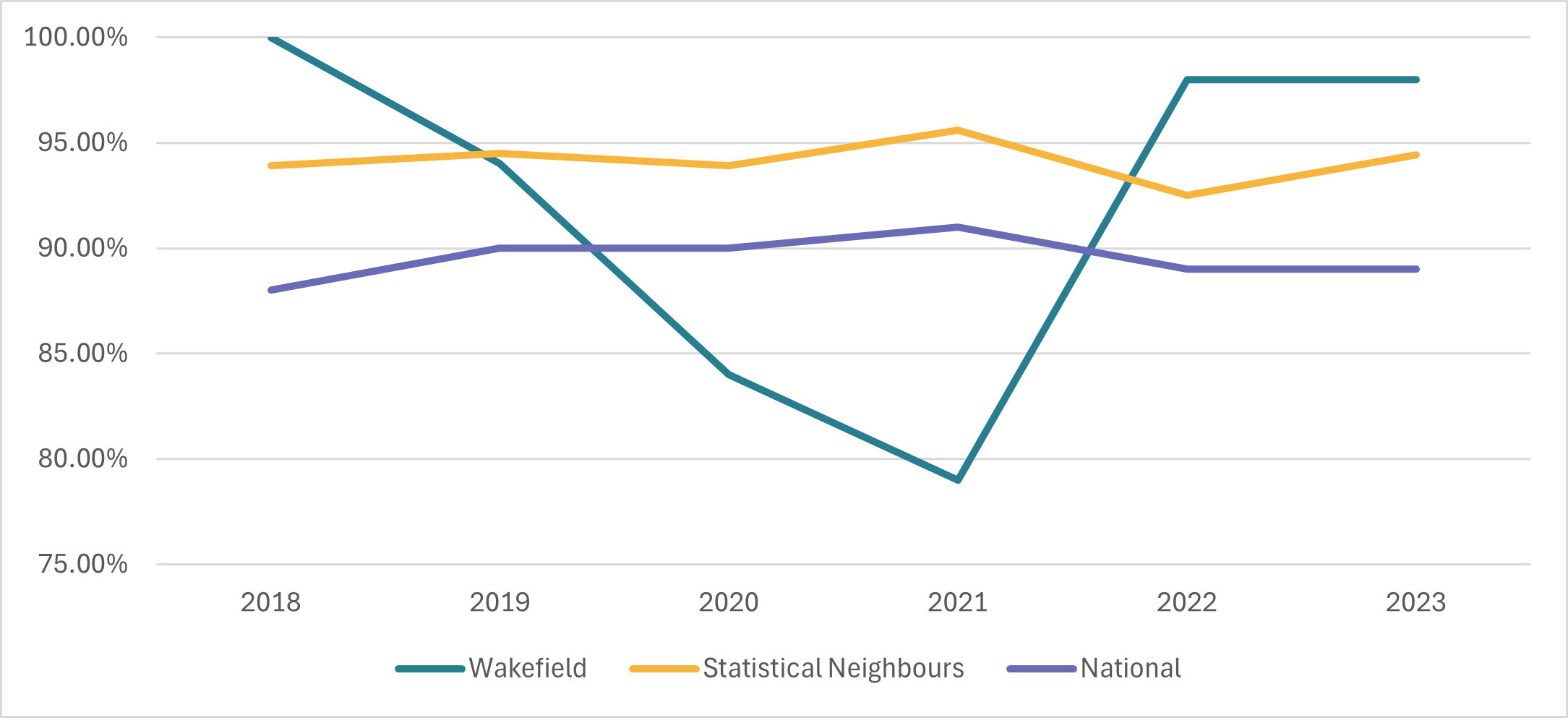
To ensure that health needs are identified and addressed, statutory health and dental checks must be carried out for CiC. The figure above shows the percentage of CiC who were in care continuously for at least 12 months and who had an annual health check in the last year.
It is important that checks are completed annually for all CiC to ensure that any issues are addressed appropriately and timely and that conditions do not deteriorate. The data shows that Wakefield have succeeded in ensuring that nearly all of the CiC have had an annual health check in the last 5 years, with 2021 naturally falling behind the norm due to Covid-19. There has since been improved performance in regard to the completion of annual health assessments in timescale with 98% of CiC in 2022 and 2023 receiving an annual health check. This figure for both years was ahead of the Statistical neighbour and National rate.
The figure below shows completion for dental checks over the same period. An annual dental check should be carried out for all CiC who have been in care continuously for 12 months. For young children under 3 years of age, who may not yet have seen a Dentist this would take the form of an oral check.
Figure 7 – Percentage of CiC having annual dental checks
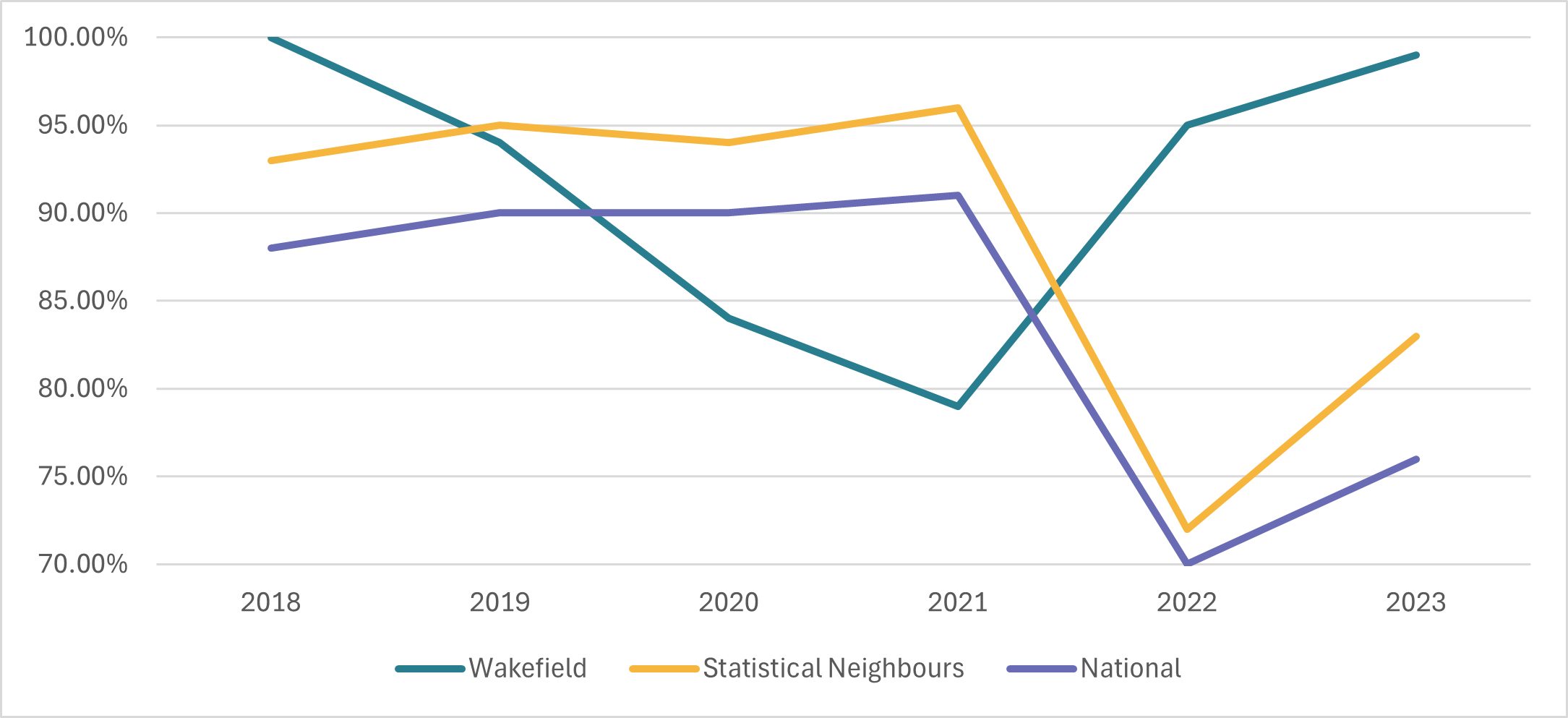
Annual dental checks saw a decrease in 2021. This was due to the the Covid pandemic when there was limited access to Dentists. Wakefield, the Statistical Neighbours and the National rate has dropped that year, as patients were not seen routinely for appointments. The rate for CIC of 99% in Wakefield was well above the statistical neighbour and national rates in 2023.
As with health checks it is vital that checks are carried out appropriately for all CiC to ensure that any preventative measures can be taken. It is known that CiC can experience more mental health issues which may be due to their previous life experiences. The strengths and difficulties questionnaire (SDQ) is a standardised and validated mental health assessment tool used to assess CIC’s emotional wellbeing. A higher score indicates there are more difficulties for a child with a score up to 15 considered low/no need, 15 – 17 indicates some/medium need and 17 and over deemed as high need. The table below shows the average SDQ score for CiC in Wakefield and comparator information.
It is known that CiC can experience more mental health issues which may be due to their previous life experiences. The strengths and difficulties questionnaire (SDQ) is a standardised and validated mental health assessment tool used to assess CIC’s emotional wellbeing. A higher score indicates there are more difficulties for a child with a score up to 15 considered low/no need, 15 – 17 indicates some/medium need and 17 and over deemed as high need.
The table below shows the average SDQ score for CiC in Wakefield and comparator information.
Table 5 – Average SDQ Score for CiC
| 2019 | 2020 | 2021 | 2022 | 2023 | |
| Wakefield | 15.00 | 13.90 | 14.80 | 14.70 | 16.10 |
| Statistical Neighbours | 14.60 | 14.30 | 13.84 | 13.85 | 14.30 |
| National | 14.20 | 14.10 | 13.70 | 13.80 | 14.40 |
The average score in Wakefield in 2022 was 14.7 which would be deemed within the low/normal range, this was slightly higher than the statistical neighbour rate of 13.85 and national rate of 13.78. However in 2023 the figure for Wakefield rose to 16.10, which is now higher then Statistical neighbour score of 14.3 and the National rate of 14.4, indicating there may be more CiC with a medium level of need.
CiC in Wakefield who have a score of 15 and over can be referred to the Emotional Wellbeing Service for support and the Service works with Children & Adolescent Mental Health Services to consider which children may need more specialist and intensive support. Nationally there has been an increased level of mental health need across the general population of children and young people but it would be helpful to look at the reasons for the increase for CiC.
Children who come into care will live in a range of settings such as foster care, children’s homes, specialist provision which provides specific support and in very rare occasions some may be in secure units. The main aim for CiC is that they can live in a long term placement and that changes to where they live are minimised. This will help secure the best outcomes for CiC. The number of placement moves is monitored for children who have been in care for 12 months or more, the figure below shows children who have had 3 or more placement moves in the last 12 months. It is important to highlight that some placement moves will be positive, for example if a child is moving in with their adoptive family or into a long term foster placement.
Figure 8 – Percentage of CiC with 3 or more placement moves in last 12 months
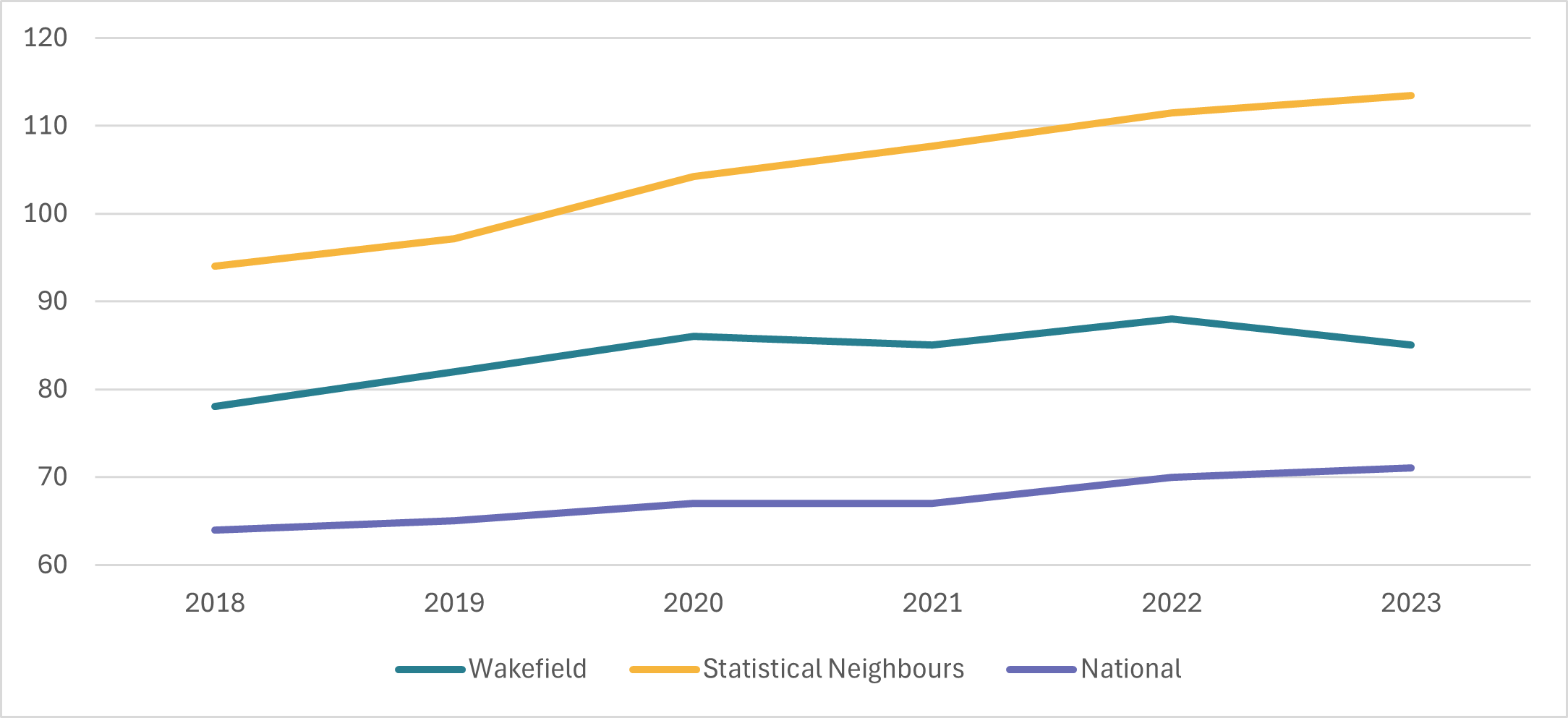
Children who come into care will live in a range of settings such as foster care, children’s homes, specialist provision which provides specific support and in very rare occasions some may be in secure units. The main aim for CiC is that they can live in a long term placement within a Foster Care setting and that changes to where they live are minimised. This will help secure the best outcomes for CiC. The number of placement moves is monitored for children who have been in care for 12 months or more, the figure below shows children who have had 3 or more placement moves in the last 12 months. It is important to highlight that some placement moves will be positive, for example if a child is moving in with their adoptive family or into a long term foster placement.
In 2023, 8% of CiC experienced 3 or more placement moves within the previous 12 months which remained the same as the previous year and was lower than prior to 2022. The rate remained lower than the Statistical neighbour (9.7%) and the National rate (10%). Within the CiC Service, processes were introduced to improve placement stability for CiC to ensure placement moves are managed and take place in a planned way rather than breaking down unexpectedly.
Another important measure for placements is the length of time that a child has been in a placement as an aim is that children have long term placements. The figure below shows the percentage of CiC who have been looked after for 2.5 years and who have been in the same placement for 2 years or more.
Figure 9 – % of CiC who have been in care for 2.5 years and in the same placement for 2 years
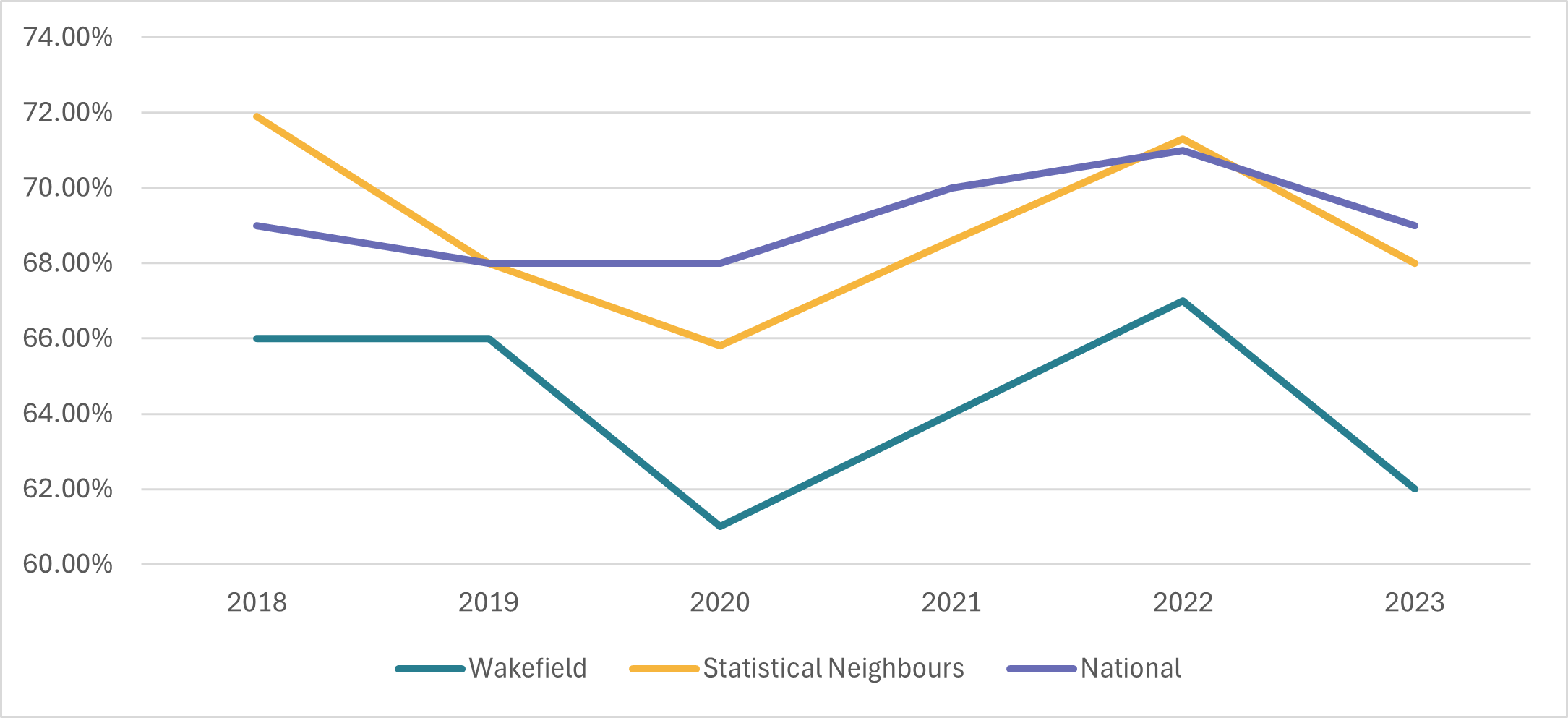
There has been a decline between 2022 (67%) and 2023 (62%) for Wakefield in regard to placement stability, despite an increase from 2021 (64%) to 2022. The rate of 62% in 2023 of CiC in the same placement for 2 years or more (of those who had been in care for 2.5 years) is below the Statistical neighbour rate of 68% and the National rate of 69%. Over the last 2 years, children’s homes in Wakefield have been transformed, moving from larger establishments accommodating multiple children into small 2 bedded homes provide more homely environments for our CiC. This has enabled some children who were placed outside of Wakefield to be able to return to their local communities and this will account for some of the reduction in the long term placement rate.
This is an area that would benefit for some further review. It should be noted that some placement moves are positive, ie children moving into an adoptive placement or moving from a residential placement to live with a long term foster carer.
3. Outcomes For Care Leavers
Young people may be legally in care up until the age of 18 although they are able to leave care from the age of 16. If the young person has been in care for a minimum of 13 weeks, some of which was after age 16 they are entitled to receive support until the age of 25 if they choose to do so.
Figure 10 – Number of Care Leavers 19 – 21 years
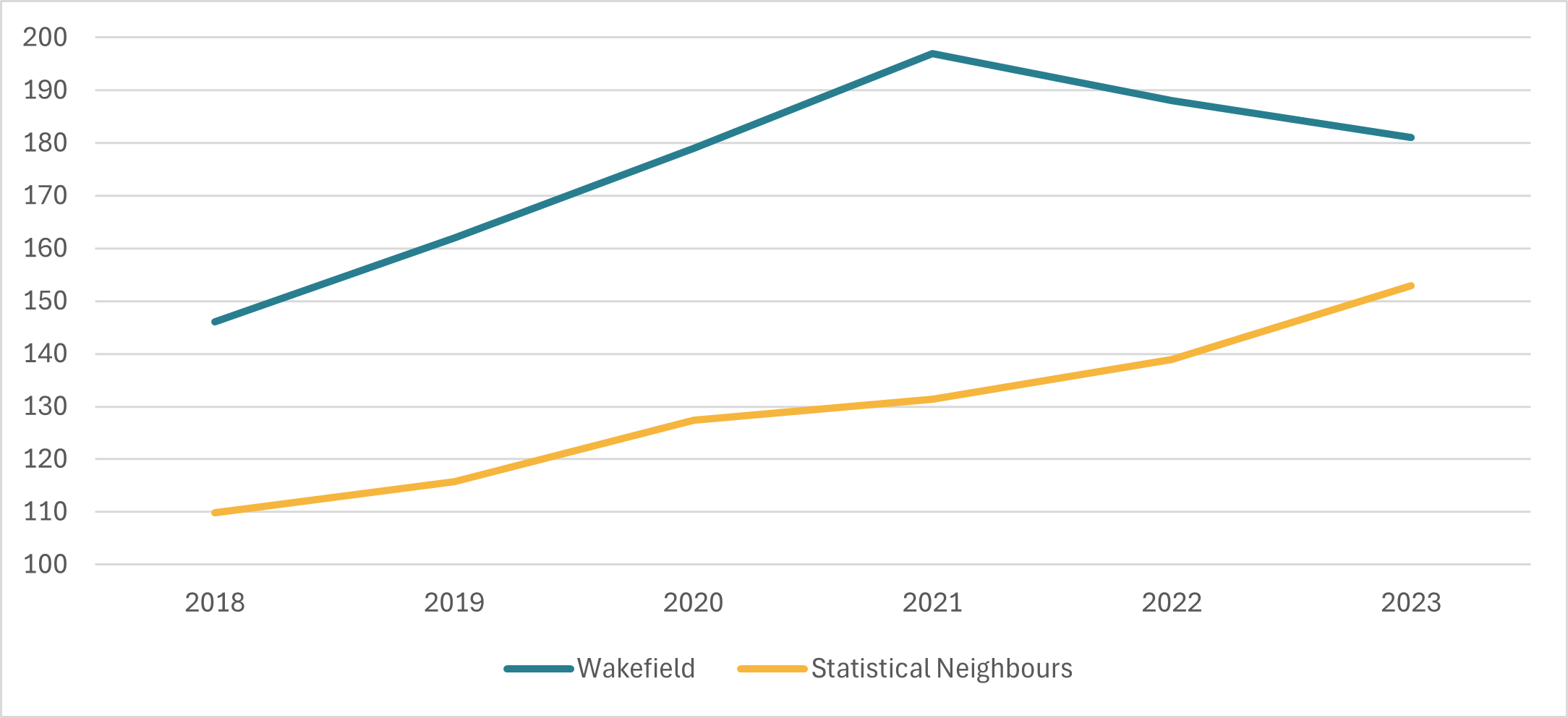
The figure above shows that in 2023 there were 181 Care Leavers aged between 19 and 21 years, which has decreased compared to the year before, when there were 188 Care Leavers. This decrease was not seen in the Statistical neighbour rate which has increased year on year from 138.9 in 2022 to 152.89 in 2023.
Table 6 – % of Care Leavers in Suitable Accommodation
| 2019 | 2020 | 2021 | 2022 | 2023 | |
| Wakefield | 74.00% | 79.00% | 84.00% | 86.00% | 83.00% |
| Statistical Neighbours | 88.67% | 92.00% | 91.90% | 90.40% | 87.67% |
| National | 85.00% | 85.00% | 88.00% | 88.00% | 88.00% |
Table 6 shows there has been a variable trend in the percentage of Care Leavers in Suitable Accommodation since 2018, although the rate has been more stable in the last 3 years. In 2023, the rate decrease slightly in Wakefield to 83%, down from 86% in 2022. This remained behind the 2023 Statistical neighbour rate (87.67%) and the National rate (88%).
The Sufficiency Strategy sets out the plan to provide placements for CiC and accommodation for Care Leavers. The Sufficiency Action Plan, which sits alongside this, focuses on providing support to secure suitable move on and independent accommodation for Care Leavers. This is achieved through working with partners such as Social Landlords as well as increasing the opportunities for Care Leavers to stay with their former Foster Carer after they turn 18. Over the last year Supported Lodgings have been developed where young people learn independence skills within a family home under extra supervision and the plan is to build on this.
Table 7 – % of Care Leavers Staying With Their Former Foster Carer
| 2019 | 2020 | 2021 | 2022 | 2023 | |
| Wakefield | 29.00% | 29.00% | 32.00% | 46.00% | 33.00% |
| Statistical Neighbours | 29.80% | 31.43% | 30.71% | 31.78% | 33.44% |
| England | 26.00% | 28,00% | 30.00% | 31.00% | 32.00% |
Although there has been a steady increase since 2020 in the percentage of Care Leavers who are staying with their former Foster Carer, rising from 29% to 46% in 2022, this rate decreased for 2023 to 33%. The 2023 Wakefield rate is similar to the Statistical neighbour rate (33.44%) and the National rate (32%).
The status of Care Leavers is tracked to determine whether they are in education, employment or training, data relating to this in the table below.
Table 8 – % of Care Leavers not in education, employment or training
| 2019 | 2020 | 2021 | 2022 | 2023 | |
| Wakefield | 39.00% | 38.00% | 32.00% | 30.00% | 44.00% |
| Statistical Neighbours | 44.80% | 42.60% | 43.50% | 35.60% | 41.22% |
| England | 39.00% | 39.00% | 41.00% | 38.00% | 38.00% |
In Wakefield in 2023, 44% of Care Leavers were not in education, employment or training (NEET), this was an increase from 30% in 2022 and higher than the 2023 Statistical neighbour (41.22%) and National rate (38%).
Personal Advisors will provide support to ensure employment, education and training opportunities are identified and sustained and a plan is developed to help every Care Leaver address challenges and progress into work or training. A Connect Cafe is in place giving Care Leavers access to facilities to look for work and apply for opportunities. Furthermore, they can also seek support from the Employment Hub and the Department for Work & Pensions.
Table 9 – Care Leavers who were in higher education
| 2019 | 2020 | 2021 | 2022 | 2023 | |
| Wakefield | 5.00% | 4.00% | 7.00% | 11.00% | 3.00% |
| Statistical Neighbour | 7.90% | 8.00% | 6.00% | 7.75% | 9.00% |
| England | 6.00% | 6.00% | 6.00% | 7.00% | 6.00% |
Table 9 above shows that in For 2023, the rate for Care Leavers who were in higher education reduced significantly to 3% compared to 11% in 2022, the lowest recorded in the last 5 years. This rate was lower than the Statistical neighbour rate of 9% and the National rate of 6%.
There has been a higher number of young people who have entered Higher Education in 2024 so the rate is likely to increase going forward, however this data is yet to be published for comparison purposed.
4. Key Findings and Recommendations
Having considered the key messages from the data the following recommendations have been identified:
- Although the increasing trend of CiC has levelled off somewhat over the last 2 years, the focus on early intervention and prevention of escalation to avoid issues escalating to a statutory level wherever possible should continue through the Wakefield Families Together approach to ensure the best outcomes for children and young people and to reduce the pressure on resources for services.
- The percentage of CiC in Wakefield who have SEN support is higher than the statistical neighbour or national rate and the level of support for this cohort may need to be considered.
- Whilst the attainment score for CiC in writing and maths was better than the statistical neighbour and national rates, writing was lower and this should be explored.
- With the average SDQ score increasing to over 16 in 2023, indicating there may be more CiC with a medium level of emotional wellbeing need, it should be confirmed that CiC are accessing support where appropriate through the EWBT or other emotional wellbeing support.
- As the percentage of CiC who have been in the same placement for over 2 years is lower than the statistical neighbour rate, the data should be reviewed to understand the reasons for these placement moves (some of which can be positive)
- Data on Care Leaver accommodation should continue to be reviewed to increase the rate so this is in line with statistical neighbours.
- Supporting more Care Leavers into employment, education or training and in particular to enter higher education should be a key focus.
5. Children in Care Service Provision
Wakefield Council’s Children in Care Services include a wide variety of services to address the needs of our CiC, complying with all statutory requirements for CiC. Some services available to local CiC include the following:
- Children in Care Social Work Teams ensuring all CiC have an allocated Social Worker who develops a nurturing relationship with the child or young person and works with them to identify their needs and ensure these are met through an effective care plan. This includes a specific Team who support young people to successfully transition to the Care Leaver Service
- Dedicated residential care homes for CIC including those with a disability with a recent programme completed transforming 4 larger homes into smaller two bedded units to provide homely environments
- A Virtual Head Teacher that supports the Education of all CIC ensuring that each child has a regular review and tailored support plan to help them to achieve their potential
- A dedicated Contact Service that supports children to stay in touch with their family and friends
- An Independent Reviewing Officer Service which ensures statutory reviews are carried out for all CiC within the statutory timescales and ensures effective implementation of care plans
- A CiC Emotional Wellbeing and Therapeutic Service to provide early support, assessment of need and therapeutic interventions for CiC to be maintained in their placements including those placed in fostering , kinship and residential care arrangements
- A dedicated team of Placement Commissioners to secure placements for CiC in foster care, secure welfare facilities, residential care and parent and baby placements
- A Fostering Team to support our Foster Carers and actively recruit new Foster Carers to ensure that CiC can live in a long term placement within their community
- Wakefield are part of a regional adoption agency, One Adoption West Yorkshire which is a regional arrangement that supports the recruitment and support of adoptive families
- The Next Steps Service provides support for Care Leavers in the district aged 16 to 25 years old.
Health Services
- NHS West Yorkshire Integrated Care Board (ICB) are responsible for delivering statutory health assessments and providing support for CiC in Wakefield. This includes an initial assessment which is carried out by a Doctor when a children or young person enters care followed by an annual review health assessment by a team of Specialist Nurses. The Specialist Nurses provide an ongoing source of support and advice to CiC, including “packages of care” to meet needs identified at health assessments, including improving understanding of healthy eating, healthy relationships, sexual health and contraception, hygiene and self-care, dental care, smoking, drugs and alcohol. They also support young people to transition to adult services and have developed a Leaving Care health summary to provide young people with important information about their health from birth. CiC are able to access universal health care services such as sexual health . All children are registered with a GP and a dentist to ensure their health needs are fully met.
CAMHS
- The ICB / sub-ICB is also commissioned to provide a dedicated CAMHS service for our CiC. In addition they co fund along with Children’s Social care an Emotional wellbeing Team with 4 practitioners offering tier 1 and 2 support to our CIC and also provide practical support for Residential Childrens Homes and Foster Carers. Wider support and training for staff and carers is also part of the team’s remit and there is close working with staff in the residential Childrens Homes, which is important when young people are not willing to directly see a mental health worker, so training for social workers and carers to support the young person is an alternative approach. Therapeutic Social workers also play an important role in supporting young people and carers when things have improved and they no longer need to be seen by the specialist service.

